Iran came to the table with regional rival Saudi Arabia and agreed to cap its oil output at around 3.8 million bopd in November 2016. following months of negotiations and uncertainty. TOGY digs deep into the reasons behind this decision following the release of The Oil &. Gas Year Iran 2016.
For Iran. 2016 began with the lifting of international sanctions that had been stifling its oil and gas industry. including exports. The country had prepared itself for increased foreign investment by releasing a draft version of the Iran Petroleum Contract in late 2015. and had prepared the groundwork to ramp up production. Production increased throughout 2016. rising from 2.94 million bopd in January to 3.7 million bopd by November.
At the same time. Iranian officials hosted international business delegations and signed agreements on future oil industry co-operation. Late in the year. deals with industry majors Shell. Total and Schlumberger marked a turning point for FDI in the market.
In the second half of 2016. OPEC intensified talks aimed at reaching a deal to cut production. Iran maintained that it should be exempt from cuts as it recovered from damage done by sanctions. But in late 2016. on the heels of a year-long production boost. Iran finally came to the table with regional rival Saudi Arabia and agreed to cap its oil output at 3.797 million bpd.

 Iran Energy News Oil, Gas, Petrochemical and Energy Field Specialized Channel
Iran Energy News Oil, Gas, Petrochemical and Energy Field Specialized Channel



